Table of Contents
Best Collaboration Tools for Remote Teams [Virtual Meetings]
Document collaboration software is becoming increasingly important in the workplace. As more companies adopt remote work models and people are working on-the-go, it’s essential to have a way to easily share information between team members. In this blog post, we’ll review two of our favorite document collaboration tools: Google Docs and Microsoft Office 365.
Google Docs allows users to edit documents in real time with up to 50 participants. The software includes a variety of features that make it easy for teams to manage their documents and collaborate effectively. For example, Google Docs allows users to track changes made by other participants and has built-in chat functionality so team members can communicate directly within documents.
Microsoft Office 365 offers some similar features as Google Docs but also has several unique offerings such as an email client that comes with 1 TB of storage space and unlimited email aliases for up to five addresses per user (for example, jsmith@companyname.com could receive emails sent to john@companyname.com).
Online Document Collaboration Software
Monday
Adjectives like monotonous, boring, dull, or tedious pop up when people think of Mondays, but Monday.com aims to change the entire notion. Monday is tailor-made to suit the needs of employees working on a team project. Teams can create personalized workflows, and Monday intelligently adapts itself to best suit the team’s needs.

Monday is perfect for businesses of all sizes and comes in with a plethora of features.
- Gives you the flexibility to assign tasks to the team members and track the progress of each member. This feature eliminates the lack of workload clarity while working on an online project.
- Their user interface is clean and lets you visualize the bigger picture through its intuitive and user-friendly layout.
- Tag team members using @, which significantly eases communication. Team members no longer need to communicate through lengthy emails for the slightest needs.
- Integrate all the applications under one roof to make it a one-stop destination for team projects. You can bring in files from Google Drive, Dropbox, and more using Monday.
- Not limited to a single platform; instead, the platform makes sure you have access to your project on all major platforms. Currently, Monday is available on the Web, Android, iPhones, and iPads.
ClickUp
ClickUp is an all-in-one application that aims to ease team collaboration projects with its specialized feature set. Its fully customizable and unique features make it a must-have for businesses of all sizes. You can easily manage group tasks, documents, reminders, goals, calendars, and more using ClickUp.
You also get messaging functionality where you can send individual or group messages on the same platform.

Some perks of using this platform include:
- You get eight different view options to manage team collaboration projects.
- There are times when a team member is working on multiple projects simultaneously. ClickUp allows you to create custom editable statuses for every individual project.
- It is a perfect tool for admins as they can assign tasks to multiple members simultaneously. Admins can track every assigned task using the table view and multitask functionality.
- ClickUp uses SCRUM methodology to provide informative yet straightforward insight into different parameters across the platform.
- The third-party integrations are seamless, and the platform lets you bring in files from all popular applications.
Try ClickUp to see how it helps.
Zoho Writer
Zoho is yet another feature-packed cloud-based word processing tool that syncs your documents in real-time. Zoho makes sure your MS Word documents get imported to the platform without any formatting errors. Also, Zoho lets you collaborate on team projects using their real-time sharing features. As you share your documents with other team members, you can see their cursor movement and the edits they make.

Some perks of using Zoho Writer include:
- The cloud-based nature of Zoho makes team collaborations efficient and swift.
- The documents you create on Zoho don’t occupy local system storage and instead get stored on Cloud.
- The real-time sync feature makes sure your documents never get tampered with in case of a calamity.
- Zoho features a fresh UI with easy navigation to all the vital word processing options.
- Administrators can control the access rights of every member in a team project and grant permissions to specific functions as well.
Dropbox Paper
Dropbox Paper is an online doc for team collaboration from the tech giant Dropbox itself. It is a no-brainer that Dropbox Paper comes with a lot more perks if your team largely depends on Dropbox to store files. Teams can easily organize documents, assign tasks, create systematic workflows, and collaborate on projects.

Moreover, the task management tools in Dropbox Paper greatly ease functions that would otherwise become complicated in an online scenario. The platform lets you mention other group members, assign tasks to others, and efficiently manage your to-dos. Some exciting features of this platform include:
- You can exchange a wide variety of multimedia on Dropbox Paper, like YouTube links, GIFs, Pinterest boards, Locations on Google Maps, audio from SoundCloud, and many more.
- Paper supports embedded previews of Inversion and Sketch files. Also, you can convert your documents into PPTs without using a third-party application.
- You can choose a template for your project from the vast template library on Dropbox Paper. There are numerous templates for brainstorming, product launches, product specifications, bug tracking projects, and more.
- Dropbox Paper comes with the option to connect your calendar to the platform. Your entire work schedule gets synced onto the platform. Paper then adapts itself, providing access to agendas, background documents, task assignments, and meeting events directly through the application.
- The mobile application gives you the feature to capture images using the camera and give feedback.
Google Docs
Google Docs is a word processing software from Google which uses a different approach to word processing. Most word processors like Word and Open Office remained offline tools that were local programs stored in a PC. On the other hand, Google Docs is a cloud-based word processor that needs online connectivity to run.
Opting for the online route opens a new world of innovations for a word-processor like team collaborations. Docs allow you to share a document with other members, making it a go-to platform for basic team collaboration. Please note that Docs is majorly a word processor, and you won’t get tailored functions like other listings in the article. That said, Docs is still a great option for team collaborations, mainly if you use it as your primary word processor.

Some perks of using Google Docs:
- Google Docs sends a notification as an email when a document gets shared with you.
- Members don’t need to sign up, especially for Docs; having a Google account is enough to use the platform.
- You can view recent revisions to a document and the members who made the tweaks.
- You can seamlessly import all significant formats of word documents on Docs.
- The real-time sync feature makes sure you never lose any data during a network interruption.
If you end up using Google Workspace for your business, you may want to check this software to turn Email into a powerful helpdesk.
Bit
Bit is not an ordinary word processor; instead, it caters predominantly to team collaboration projects. You can create quick dynamic notes, documents, wikis, knowledge bases, projects, client deliverables, technical docs, and more using powerful management tools on Bit. Moreover, you get to create separate workspaces for all your projects.
Collaborating on Bit is efficient and helps you maintain transparency between different team members.https://www.youtube.com/embed/3KtcKdMw3vs?feature=oembed
Some benefits of using Bit:
- The Workspace feature on Bit lets you organize your projects, clients, and teams. You can also move documents between different workspaces, eliminating the hassle of uploading the same file multiple times.
- The mention feature using “@” is a great efficiency booster while working in team collaborations.
- Bit comes with a minimalistic yet innovative editor that lets you effortlessly create documents. The efficiency gets further boosted by coupling the editor and real-time collaboration features.
- You can add visual web links, rich media, videos, graphics, designs, embeds, social media posts, surveys, and a lot more right into the editor.
- Bit also gives you the feature to track the engagement of the documents you shared. These insights are a great way to improve your documents and gain more traction.
- You can save all your essential files on Bit to enhance the cross-platform usability of the solution.
Confluence
Confluence is a shared workspace that lets teams collaborate, organize, and publish efficiently. It is open and collaborative, helping your team to bring out their best work together. It often gets hard to track edits, comments, or feedbacks made by other team members, but this platform addresses the problem. You get a universal search option that lets you search the entire workspace and find matching information.

Some perks of using this platform include:
- Confluence lets you integrate applications from the Atlassian Marketplace. The Atlassian Marketplace is home to more than 3,000 applications that you can add to the platform.
- The platform is available on multiple platforms like Android, iOS, and the Web.
- It offers first-class Jira integration straight into the platform.
- You get fantastic organizational features, and the universal search option is a major dealbreaker.
- There are loads of beautiful templates for Marketing, Product, HR, and more in the template library.
- You get seamless integration with popular platforms such as Trello, Slack, Microsoft Office, Invision, Dropbox, Google Drive, and more.
- Confluence sites follow privacy controls and industry-verified standards of data encryption.
Microsoft Word
Microsoft Word has been a synonym for word processing software for a pretty long time. Word has always been the industry leader in providing a simplified yet powerful word processing solution. Still, Microsoft has taken the software to an upper notch by introducing team collaboration features. The latest version of Word brings in a plenty of features like:
- You get the feature to transform documents into web pages without using any third-party application.
- You can easily share a document with team members using the real-time sharing feature in Word.
- Word comes with an in-built translator that is especially helpful while working with members from different cultural backgrounds.
- You can add 3D models directly to your documents using Word.
- The real-time sync feature makes sure you never lose your documents.
- Word is now available on Android, iOS, Web, and Windows, easing cross-platform workflows.

Notion
You expected this, don’t you?
Notion is the most feature-packed and easy-to-use platform for team collaboration on this list. The platform lets businesses streamline their operations to set goals, track the workflow status, lead management, and more through one centralized tool. It comes with a drag-and-drop interface to help you organize, rearrange, and develop new ideas or plans.https://www.youtube.com/embed/3KtcKdMw3vs?feature=oembed
Notion comes with significant benefits for team collaboration such as:
- Notion lets businesses create and maintain a knowledge base for numerous tasks like project guidelines, coding instructions, HR workflows, and more.
- The platform comes with a built-in calendar and Kanban boards that team members can use to create quick notes and track their progress.
- Team members can add comments on tasks and projects for better communication and transparency.
- You can use Notion’s API to integrate their systems with various third-party applications such as Slack, Figma, and Invision.
- Creating to-do lists, preparing meeting notes, and setting up weekly agendas become excessively easy using the unified platform.
You can also use Notion on your custom domain. However, if you are not happy for whatever reason, you can try the above-listed online docs software for collaboration as a Notion alternative.
collaborative document editing
As the Coronavirus pandemic continues to be a threat, almost all tech companies are working remotely to keep the spread of the virus to a minimum. Although the move to shift the workplace as online-only was made to counter the spread of COVID-19, remote work has been picking up steam from the past few years due to its numerous benefits
- Save on office finances like rent, utilities, stationery, etc.
- Save commute time for employees
- Reduce unnecessary office meetings, politics, watercooler discussions, and other known time-wasters.
- Hire a diverse workforce without geographical limitations

The shift towards remote working has led to the acceleration of many collaborative document editing software that helps distributed teams work like they in the same room.McKinsey reports that knowledge workers spend an average of 14% of their workweek communicating and collaborating internally. The report also pointed out that improving internal collaboration through social tools could help raise the productivity of interactions by as much as 20 to 25 percent!
Since a lot of time in the office is spent on communicating and collaborating on documents, collaborative document editing software makes it easy for remote teams to work efficiently. There are many advantages of using collaborative document editing software:
- Faster problem solving
- Hub for brainstorming ideas
- Improved efficiency and productivity
- Builds community and fosters teamwork
- Quick execution of ideas
- Less time spent in an email inbox
For those who don’t know, collaborative document editing software allows employees to view, edit, and work simultaneously on a document without the need of sending back-and-forth emails.
In this blog post, we are going to uncover some of the best collaborative document editing software out there and see which one stands out of the crowd. So without further ado, let’s begin…
List of Best Collaborative Document Editing Software:
Research suggests that teams can create documents 33% faster with a document management tool that cuts out the need for attachments. These collaborative document editing software are essential for working in a remote environment as they streamline workflows, reduce inefficiencies, and bring the team together under one roof. Here are our top picks:
#1: Bit.ai
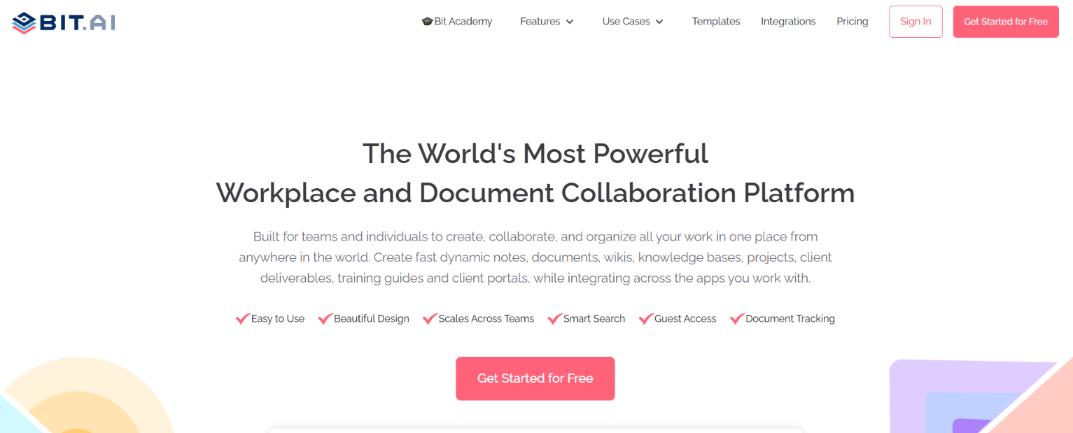
The number 1 tool on our list is Bit, a modern collaborative document editing software for teams of all shapes and sizes. Bit allows teams to create, manage, share, and track documents from one easy to use dashboard.
Bit has a number of outstanding abilities that makes it one of the best collaborative document editing software out there:
- Organized workspaces and folders: Bit brings all your documents and files in one place by allowing you to organize information in workspaces and folders.
- Real-time collaboration: Collaborate with your team and management and feedback in real-time using @mentions and highlight features as every document comes with its separate comment stream. You can also ping collaborators to notify them of any changes or call them to a doc in case you need their help.
- Content library: Bit has a content library where you can store and share media assets. You can save images, files, videos, PDFs, and content easily and can access it at any point.
- Rich embed options: Bit.ai integrates with over 100+ web applications (Ex: YouTube, PDFs, LucidChart, Google Drive, etc.) to help you create media-rich and interactive implementation plans or other workplace documents.
- Smart search: Bit has very robust search functionality that allows anyone to find information quickly. You can search for folders, files, documents, and content inside your documents across all of your workspaces.
- Interlink documents: Bit allows employees to create unlimited documents and interlink them to create robust internal wikis.
- Templates: Bit has a plethora of amazing templates that cut your work in half and help you kickstart your work quickly.
- Other features: Document tracking, version history, smart permissions, lead capture, and more.
Some standout features of Bit
- Track documents shared internally or externally.
- Content library to store media files
- In-built chat functionality, password protection, etc.
- Embed documents on any website
Pricing:
- Free with limited functionality
- Paid plans start from: Standard ($12/month), Plus ($20/month), Enterprise (contact sales).
#2. Google Docs
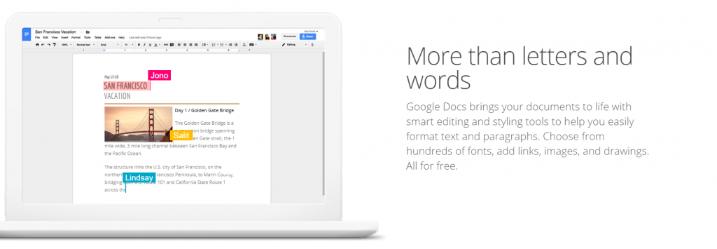

Next up is Google Docs, a free cloud collaboration platform by Google. The platform works similarly as Word online as Google has a clean editor you can use to simultaneously edit documents with your teammates. The only pre-requisite is a Google ID or Gmail account to get started.
As Google Docs works in the cloud, there’s no need to download separate software. Simply log in to your Google account and start creating docs easily. If you have been using Word, Google Docs will definitely feel familiar to you. The top bar is filled with formatting and editing options, just like Microsoft Word has. Built with collaboration in mind, Google docs allow you to create a doc and share it with your teammates via email or a shareable link.
With 15GB of cloud storage on their free plan, Google Docs is a decent tool for individuals or solopreneurs looking to host their documents on the cloud. If you have a large team, we would suggest you look elsewhere. You can always upgrade to a paid account if you need more storage.
Some standout features of Google Docs
- Highlight and add comments for feedback
- Store documents in Google Drive with one click
- Integrates with Google Slides, Spreadsheets, Keep, and more.
Pricing:
- Free with limited functionality
- Paid plans start from $6 per user/month
#3: Microsoft Word Online
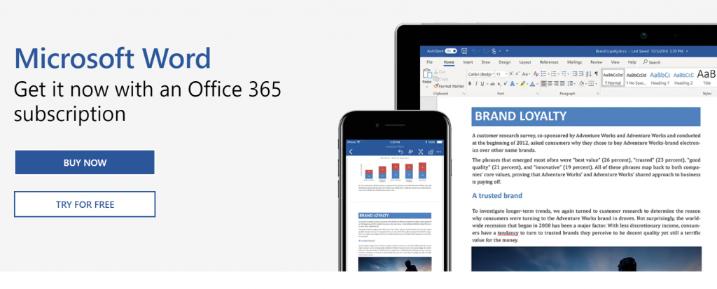
One of the most popular document editors out there, Microsoft Word also has a cloud-based counterpart. Microsoft Word online offers the functionality of Word over the cloud, allowing users to access it via the internet and edit documents in real-time.
Competing with the likes of Google Docs, Microsoft Word online offers free access to all Microsoft tools such as Word, Onenote, Excel, Powerpoint, One Drive, etc- all you need is a Microsoft account to access its productivity apps. The online Word has a similar interface to the traditional Word, with some added features to appeal to modern users and their needs. However, Word is still very traditional in their approach and lacks key features of modern-day document editors.
Teams can co-author and co-edit word documents simultaneously and get their work done quickly. They can upload documents from their PC through Word-OneDrive integration or can directly open documents through Dropbox. Done creating your docs? Download them as Office files or as a PDF or in ODF format.
Some standout features of Word Online
- Familiar interface
- Safe and secure
- Integrates with Powerpoint, Excel, OneDrive, Teams, and other Microsoft products
Pricing:
- Free with limited functionality
- Paid plans start from Business Essentials ($6/month), Business ($8.25/month), Business Premium ($12.50/month)
#4: Quip

A product by Salesforce, Quip is another competent collaborative document editing platform. Create and edit live documents and spreadsheets, chat with teammates, and discuss ideas effectively via threads for each document. Teams can even add a document or a spreadsheet to a chat and work on it together. Users use Quip to create, organize, and discuss work with efficiency and transparency.
A robust Salesforce integration means that Quip can bring your Salesforce data inside, allowing you to live edit docs and spreadsheets with co-workers. A great feature of Quip is the ability to add calendars, kanban boards, polls, countdowns, etc to your documents, and keep all your work in one place.
Dedicated Android and iOS apps mean that you can take your work with you wherever you go. Quip also supports offline mode as you can work without an internet connection and your work will get synced whenever you next connect to the internet.
Some standout features of Quip
- Brings docs, slides, spreadsheets under one roof
- Version history and offline mode
- Team chat rooms
Pricing:
- Free with limited functionality
- Paid plans start from: Starter ($10 per/month), Enterprise ($25 per user /month), Quip for Customer 360 (contact for a quote)
#5. Box Notes
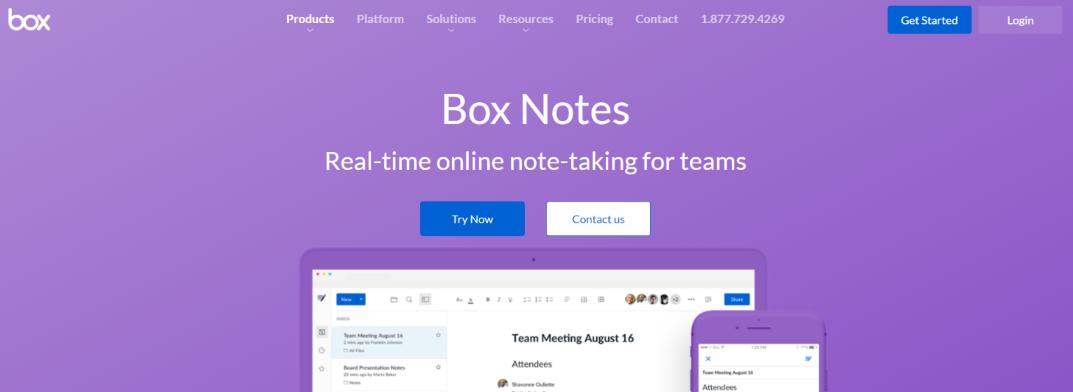
While many think of Box as this amazing file-storage platform and Dropbox competitor, Box also has a note-taking app for real-time collaborative editing. Box Notes allows employees to create and edit work notes together, along with the ability to add comments and basic formatting options.
The USP (unique selling proposition) of Box notes is its clean editor that is perfect for jotting down notes, organize reviews, or even start a newsletter. Built with corporations in mind, Box Notes is a serious note-taking app and allows employees to store meeting notes, plan projects, brainstorm ideas, create to-dos and deadlines, and more.
The version control feature allows users to easily reference all changes and revert back to past versions at any point. If you already use Box for file storage, Box Notes might be a great addition to your workflow. The platform also has a desktop app (for both Windows and Mac).
Some standout features of Box Notes
- Enterprise-grade security
- Desktop and mobile apps
- Annotations can be made anywhere
Pricing:
- Free with limited functionality
- Paid plans start from Personal pro ($11.50/month), Business starter ($5.80/month), Business ($17.30/month), Enterprise (contact for a quote)
#6: Confluence
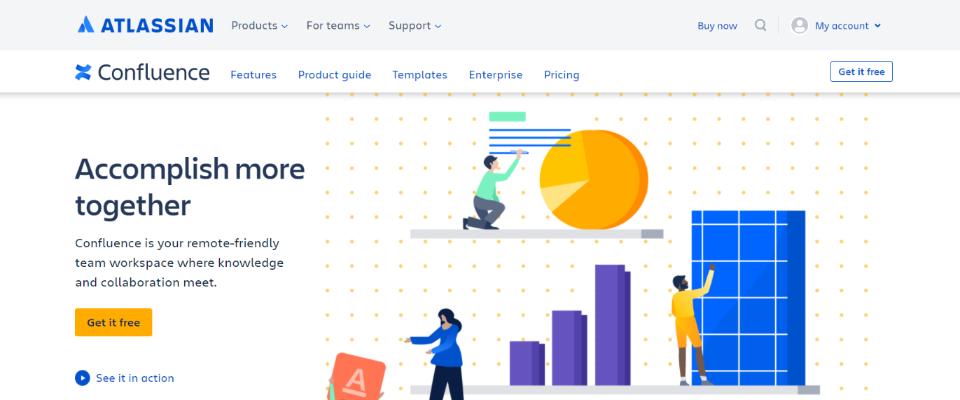
Over 60,000 users worldwide use Confluence to edit their docue=ments collaboratively and get work done. A product by software giant Atlassian, Confluence allows teams to create, share, and collaborate on docs, presentations, spreadsheets, and even images. COnfluence breaks down organizational silos, thanks to its robust chat functionality and sharing options.
Employees can easily pin comments on the shared file, edit files together, and give their suggestions or feedback, right from Confluence’s dashboard. Departments and teams can create Spaces, allowing them to compartmentalize and organize their work based on the project they are working on.
Choose from over 75 customizable templates to kickstart your work and alert your teammates when you tag them or assign them a task. Confluence integrates with JIRA, Trello, Hubspot, and Google apps and brings everything together.
Some standout features of Confluence
- Home and personalized feed
- Blogs to make announcements
- Permission settings to keep things private
Pricing:
- Free with limited functionality
- Paid plans start from Standard ($10/month for up to 10 users), Premium ($100/month)
#7. Sharepoint
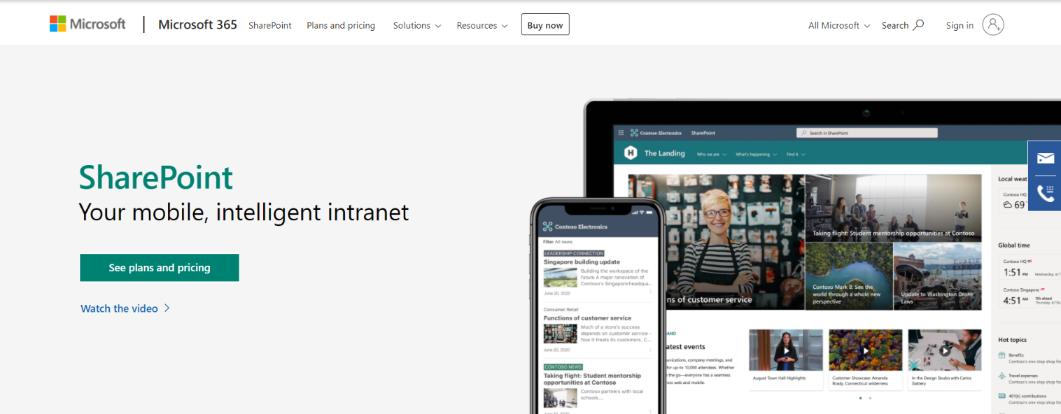
Another veteran like Confluence, Sharepoint is a Microsoft owned collaboration and intranet software. It is a part of the Microsoft Office 365 package and integrates seamlessly with other Microsoft products like Teams, Word, OneDrive, and more. With over 2 decades of experience, Sharepoint knows what it’s doing. Providing a safe space to share and collaborate on knowledge, Sharepoint streamlines your team’s work.
A go-to collaboration platform for enterprises, Sharepoint as over 190 million customers worldwide. teams can share data, media, and other resources across departments and divisions. With Sharepoint sites, teams can create communication hubs and customize them according to their needs. Sharepoint has a very powerful search feature, allowing anyone in the organization to quickly find any piece of information, making them more productive. While great at what it does, Sharepoint can be hard to implement and the learning curve can be very steep.
Some standout features of Sharepoint
- Available for Mac, PC, and mobile apps
- Integrates with other Microsoft products
- Create customizable team sites
Pricing:
- Free with limited functionality
- Paid plans start from: SharePoint Online Plan 1 ($5 per user /month), SharePoint Online Plan 2($10 per user /month), Office 365 E3 ($20 per user/month)
#8. Samepage
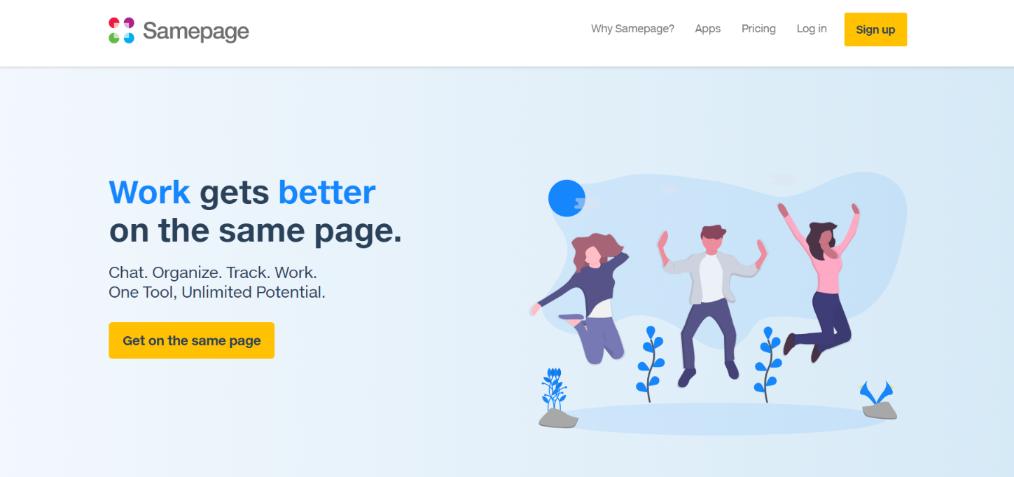
As the name suggests, SamePage wants your team to be on the same page by allowing them to collaboratively edit documents and file in the cloud. With features like- screen sharing, file sharing, team chat, video calls, task management, and real-time document management, Samepage has got all basis covered for being a great collaboration platform.
Teams can organize projects on the kanban board, or use mindmaps, pages or sheets, to schedule upcoming projects. Employees can assign tasks to co-workers, add due dates, set priority levels, create reminders, subtasks, and add description details to give context. The platform is highly flexible but can be cumbersome to use, especially for new users.
Samepage also has native Android, iOS, and Mac apps to help you stay connected and receive all project-related updates no matter where you are.
Some standout features of Samepage
- Video conferencing and chat
- Link files with Box, Dropbox, Onedrive, or Google Drive
- Kanban boards and mind maps
Pricing:
- Free with limited functionality
- Paid plans start from Standard ($6.50 per user per month), Pro ($8 per user per month)
#9: Zoho Docs
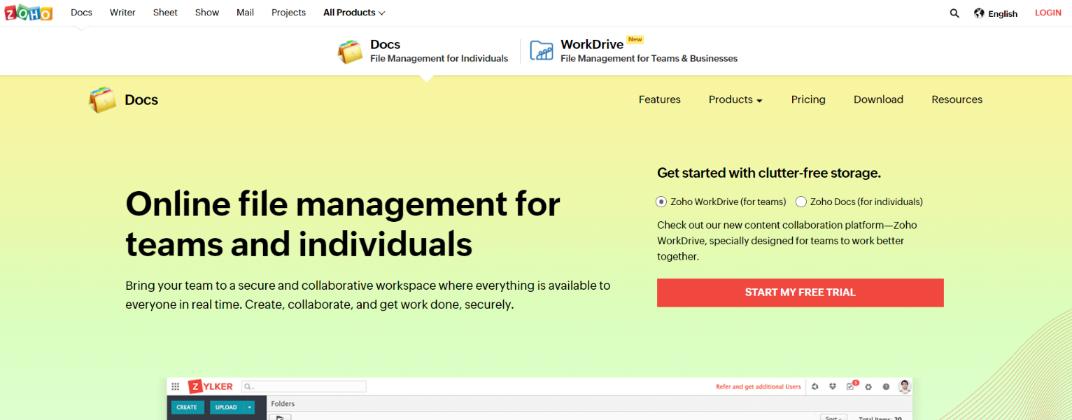
Zoho Docs is a document management platform by Zoho. Zoho provides tools to create documents, spreadsheets, and presentations- all form a neat dashboard. Zoho Writer is the name of the collaborative document editor that allows teams to edit documents in real-time. With its similarity to Microsoft Word, Zoho brings a new spin to the age-old document editors and allows the creation, storage, and sharing of documents easily.
Teammates can set permissions, password-protect their docs, or even set an expiration time after which, everyone loses access to the file or document. Zoho Docs also provides the ability to chat with collaborators in real-time to make document editing easier. With writing modes, Zoho accommodates itself to the phase of document creation you are in- compose, review, or distribution.
Zoho Writer has over 350+ fonts and provides a plethora of editing options. An advanced document review system onboard, Zoho allows teams to search and filter through comments, track change history, get email updates, turn off live cursors, and reply to the comments happening on the doc directly from the email.
Some standout features of Zoho Writer
- Integrates with DocuSign and Adobe EchoSign
- Post content directly to WordPress
- Lock portions of a document for editing
Pricing:
- Free to use
Conclusion
Let us know your thoughts in the comment section below.
Check out other publications to gain access to more digital resources if you are just starting out with Flux Resource.
Also contact us today to optimize your business(s)/Brand(s) for Search Engines
